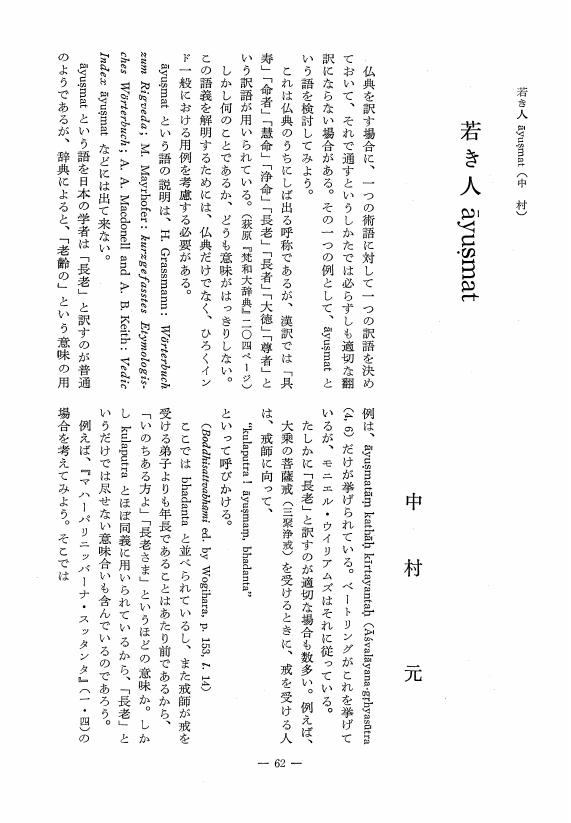3 0 0 0 OA 悪人正機説の系譜について
- 著者
- 梶村 昇
- 出版者
- JAPANESE ASSOCIATION OF INDIAN AND BUDDHIST STUDIES
- 雑誌
- 印度學佛教學研究 (ISSN:00194344)
- 巻号頁・発行日
- vol.19, no.1, pp.348-353, 1970-12-25 (Released:2010-03-09)
3 0 0 0 世親淨土論に於ける十地經的要素
- 著者
- 長谷岡 一也
- 出版者
- JAPANESE ASSOCIATION OF INDIAN AND BUDDHIST STUDIES
- 雑誌
- 印度學佛教學研究 (ISSN:00194344)
- 巻号頁・発行日
- vol.6, no.2, pp.493-496, 1958
3 0 0 0 OA シャンカラにおける瞑想の一側面
- 著者
- 村上 幸三
- 出版者
- 日本印度学仏教学会
- 雑誌
- 印度學佛教學研究 (ISSN:00194344)
- 巻号頁・発行日
- vol.39, no.2, pp.964-962, 1991-03-20 (Released:2010-03-09)
3 0 0 0 OA 佛教心理學の成立と課題
- 著者
- 西光 義敞
- 出版者
- JAPANESE ASSOCIATION OF INDIAN AND BUDDHIST STUDIES
- 雑誌
- 印度學佛教學研究 (ISSN:00194344)
- 巻号頁・発行日
- vol.6, no.2, pp.461-464, 1958-03-30 (Released:2010-03-09)
3 0 0 0 OA naksatra-「月宿」の成立 : ヴェーダ暦と祭式・儀礼
- 著者
- 阪本(後藤) 純子
- 出版者
- 日本印度学仏教学会
- 雑誌
- 印度學佛教學研究 (ISSN:00194344)
- 巻号頁・発行日
- vol.59, no.3, pp.1075-1083, 2011-03-25
ヴェーダ文献(紀元前1200-500年頃)に残る太陰太陽暦では,月の形態および月と白道近辺の恒星の位置関係により月日が決定される.祭式の日時を決定するために月の朔望と運動が注意深く観察され,naksatra-「月宿」の概念が成立する.月は朔から朔の間(1朔望月:約29.53日),白道近辺にほぼ等間隔に位置する恒星(群)に順次近づき,朔の夜(amavasya-)には太陽と合一して姿を消す.これらの恒星(群)(RVでは太陽を含む)はnaksatra-「(月が)到達する所」「月宿」と呼ばれ,月と恒星との位置関係を示す指標となる.krttikas(Pleiades昴)を起点とするこれらの恒星(群)は,ヨーロッパ青銅器時代の考古学遺品(Nebra Sky Disk)が示唆するように,ヴェーダ期を遙かに遡る古代に起源を持つ可能性がある.Naksatra崇拝や婚姻・戦闘等のために吉祥なNaksatraを選ぶ風習は,光(太陽・火)を崇め闇・夜を避ける傾向の強いヴェーダ祭式よりも,むしろ民間儀礼において発達し,部分的にシュラウタ祭式に取り入れられた形跡が伺える.Naksatraの列挙はAtharvaveda XIX 7,Yajurveda-Samhitaマントラ(Agnicayana火壇第五層のNaksatra煉瓦:Maitrayani Samhita II 13,20,Kathaka-Samhita XXXIX 13,Taittiriya-Samhita IV 4,10),Taittiriya-Brahmanaマントラ(15,1:Naksatra祭?),マントラと散文(III 1:Naksatra献供)に見られ,さらに部分的にTB散文(I 5,2-3:Naksatra解説)にも残るが,いずれも後代の補遺部分とみなされる.これらのNaksatraの列挙は,朔望月に基づく28 Naksatra方式と恒星月に基づく27 Naksatra方式に分類されるが,前者は月と恒星の位置を正確に反映せず,後者は朔望月の日付と対応しない.この矛盾を解決するために,上記Agnicayanaのマントラおよびシュラウタ・スートラでは,本来は次元の異なる概念である満月・朔の夜を27 Naksatraに付け加えるなどの工夫が試みられる.より平易な28方式は一般大衆の民間儀礼に好まれ,より正確な27方式は祭官学者間に普及したことが上記文献から推測される.(後者はJyotisa以降の天文学において黄道の均等な27区分に変質する.)
3 0 0 0 OA サンスクリット文學に於ける HAMSA について
- 著者
- 長柄 行光
- 出版者
- JAPANESE ASSOCIATION OF INDIAN AND BUDDHIST STUDIES
- 雑誌
- 印度學佛教學研究 (ISSN:00194344)
- 巻号頁・発行日
- vol.17, no.2, pp.609-614, 1969-03-31 (Released:2010-03-09)
3 0 0 0 OA 現代に於ける殉教思想 -ある日本人僧侶の殉教を通して-
- 著者
- 笹森 行周
- 出版者
- JAPANESE ASSOCIATION OF INDIAN AND BUDDHIST STUDIES
- 雑誌
- 印度學佛教學研究 (ISSN:00194344)
- 巻号頁・発行日
- vol.55, no.2, pp.1028-1025,1291, 2007-03-20 (Released:2010-07-01)
Rev. Yokotsuka (1952-1984) was a disciple of the Most Ven. Nichidatsu Fujii, founder of Nipponzan Myohoji Buddhist Order in Japan. In Sri Lanka for 6 years he had been praying to bring about peace among peoples there.However he was shot dead on the street in Jaffna on 28 Oct. 1984 at the age of 32, while he was bowing to show veneration to the men who were going to assassinate him. This practice of bowing, through the veneration and worship of the Buddha-nature existing in all beings, is based on the practice by the Never Despising Bodhisattva in Chapter 20 of the Lotus Sutra.Rev. Yokotsuka's martyrdom was nothing more than an encounter between violence and the practice of Bowing, the supreme way of non-violence which in Japan was first practiced and embodied by the 13th. century's great monk Nichiren (1222-1282).Rev. Yokotsuka showed us some ideas of the Bodhisattva's vows taken by Mahayana Buddhist who see no enemies around them, believing that everyone is to become a Buddha. The practitioners find their places of mission voluntarily amongst real troubles. They practice the Bodhisattva's vows without the fear that they will be misunderstood, ridiculed, or beaten to death. This is the significance of Martyrdom in the present-day.
3 0 0 0 OA パタムパ・サンゲの遺誡について
- 著者
- 西岡 祖秀
- 出版者
- 日本印度学仏教学会
- 雑誌
- 印度學佛教學研究 (ISSN:00194344)
- 巻号頁・発行日
- vol.58, no.1, pp.483-476, 2009-12-20
3 0 0 0 OA 普遍の觀念を手がかりとするヴァイシェーシカ體系の考察
- 著者
- 中村 元
- 出版者
- JAPANESE ASSOCIATION OF INDIAN AND BUDDHIST STUDIES
- 雑誌
- 印度學佛教學研究 (ISSN:00194344)
- 巻号頁・発行日
- vol.7, no.2, pp.695-708, 1959-03-30 (Released:2010-03-09)
3 0 0 0 OA asrava について
- 著者
- 榎本 文雄
- 出版者
- JAPANESE ASSOCIATION OF INDIAN AND BUDDHIST STUDIES
- 雑誌
- 印度學佛教學研究 (ISSN:00194344)
- 巻号頁・発行日
- vol.27, no.1, pp.158-159, 1978-12-31 (Released:2010-03-09)
- 著者
- 橘川 智昭
- 出版者
- 日本印度学仏教学会
- 雑誌
- 印度學佛教學研究 (ISSN:00194344)
- 巻号頁・発行日
- vol.59, no.2, pp.591-596, 2011-03-20
3 0 0 0 OA 出征するジャイナ教在家信者
- 著者
- 河〓 豊
- 出版者
- 日本印度学仏教学会
- 雑誌
- 印度學佛教學研究 (ISSN:00194344)
- 巻号頁・発行日
- vol.53, no.1, pp.436-432, 2004-12-20
3 0 0 0 OA 般若経類のsunyaとsunyata : 『般若心経』の解明
- 著者
- 阿 理生
- 出版者
- 日本印度学仏教学会
- 雑誌
- 印度學佛教學研究 (ISSN:00194344)
- 巻号頁・発行日
- vol.57, no.2, pp.965-960, 2009-03-20
2 0 0 0 OA 仏典におけるナーガ
- 著者
- 定方 晟
- 出版者
- Japanese Association of Indian and Buddhist Studies
- 雑誌
- 印度學佛教學研究 (ISSN:00194344)
- 巻号頁・発行日
- vol.20, no.1, pp.443-437, 1971-12-31 (Released:2010-03-09)
2 0 0 0 OA ヨーガ・スートラの成立と佛教との關係
- 著者
- 金倉 圓照
- 出版者
- Japanese Association of Indian and Buddhist Studies
- 雑誌
- 印度學佛教學研究 (ISSN:00194344)
- 巻号頁・発行日
- vol.1, no.2, pp.259-268, 1953-03-25 (Released:2010-03-12)
2 0 0 0 OA 高麗大蔵経の版木に関する一考察 -影印本を中心として-
- 著者
- 馬場 久幸
- 出版者
- Japanese Association of Indian and Buddhist Studies
- 雑誌
- 印度學佛教學研究 (ISSN:00194344)
- 巻号頁・発行日
- vol.51, no.2, pp.634-636, 2003-03-20 (Released:2010-03-09)
2 0 0 0 OA 若き人 ayusmat
- 著者
- 中村 元
- 出版者
- Japanese Association of Indian and Buddhist Studies
- 雑誌
- 印度學佛教學研究 (ISSN:00194344)
- 巻号頁・発行日
- vol.32, no.1, pp.62-66, 1983-12-25 (Released:2010-03-09)
2 0 0 0 OA 日蓮遺文『不動愛染感見記』小考
- 著者
- 高森 大乗
- 出版者
- Japanese Association of Indian and Buddhist Studies
- 雑誌
- 印度學佛教學研究 (ISSN:00194344)
- 巻号頁・発行日
- vol.50, no.1, pp.98-102, 2001-12-20 (Released:2010-03-09)
2 0 0 0 OA 源翁心昭と山林料〓
- 著者
- 石川 力山
- 出版者
- Japanese Association of Indian and Buddhist Studies
- 雑誌
- 印度學佛教學研究 (ISSN:00194344)
- 巻号頁・発行日
- vol.32, no.2, pp.597-602, 1984-03-25 (Released:2010-03-09)
2 0 0 0 OA 高崎直道先生を偲ぶ
- 著者
- 斎藤 明
- 出版者
- 日本印度学仏教学会
- 雑誌
- 印度學佛教學研究 (ISSN:00194344)
- 巻号頁・発行日
- vol.62, no.2, pp.777-782, 2014-03-20 (Released:2017-09-01)

















